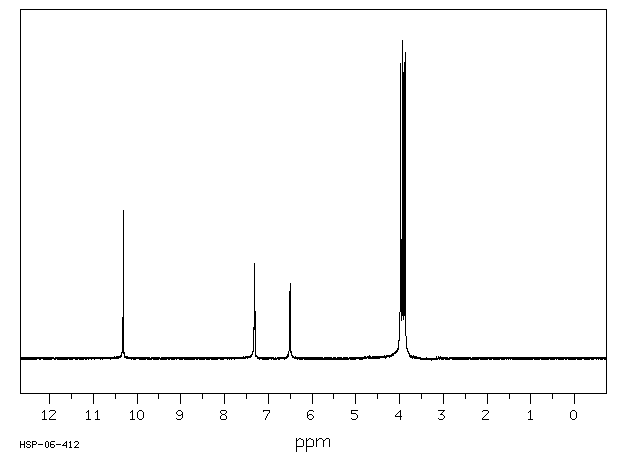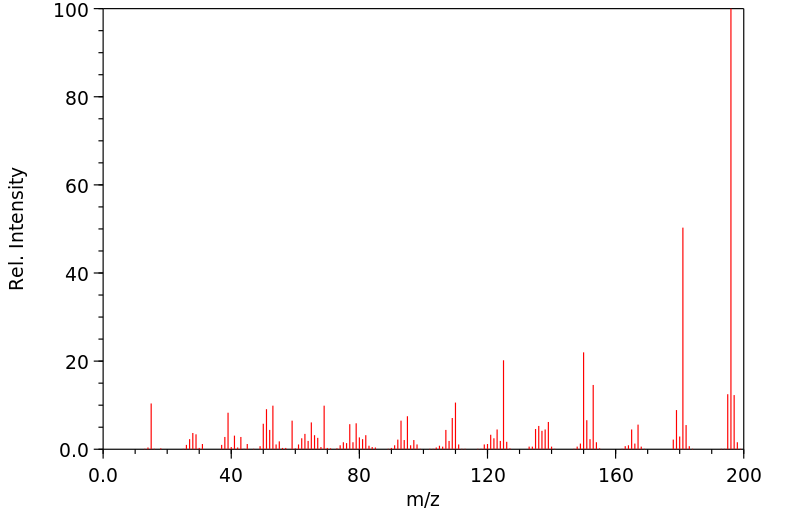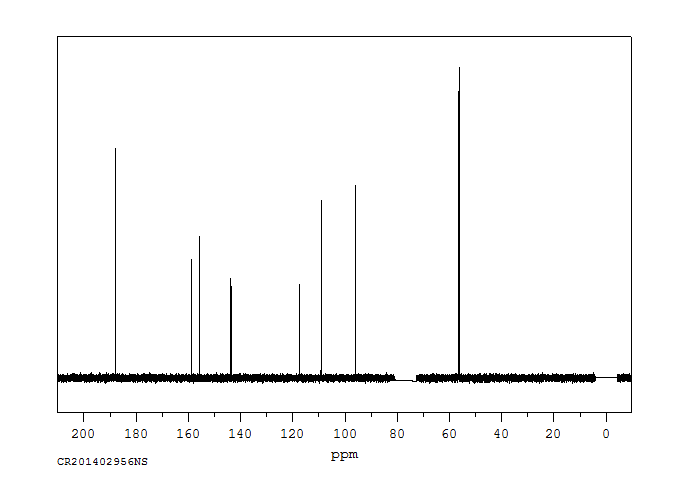2,4,5-三甲氧基苯甲醛 | 4460-86-0
中文名称
2,4,5-三甲氧基苯甲醛
中文别名
细辛醛;环胞霉素A.环孢素A;2,4,5-三甲氧苯醛;2,4,5-三甲氧基苯(甲)醛
英文名称
asaraldehyde
英文别名
2,4,5-trimethoxybenzaldehyde;asaronaldehyde;asarylaldehyde
CAS
4460-86-0
化学式
C10H12O4
mdl
MFCD00003312
分子量
196.203
InChiKey
IAJBQAYHSQIQRE-UHFFFAOYSA-N
BEILSTEIN
——
EINECS
——
-
物化性质
-
计算性质
-
ADMET
-
安全信息
-
SDS
-
制备方法与用途
-
上下游信息
-
文献信息
-
表征谱图
-
同类化合物
-
相关功能分类
-
相关结构分类
物化性质
-
熔点:112-114 °C (lit.)
-
沸点:140°C 4mm
-
密度:1.2166 (rough estimate)
-
闪点:140°C/4mm subl.
-
溶解度:可溶于氯仿(少许)、乙酸乙酯(少许)、甲醇(少许)
-
LogP:1.634 (est)
-
物理描述:2,4,5-trimethoxybenzaldehyde is a beige powder. (NTP, 1992)
-
蒸汽压力:1.13X10-3 mm Hg at 25 °C (est)
-
碰撞截面:138.3 Ų [M+H]+ [CCS Type: TW, Method: calibrated with polyalanine and drug standards]
-
保留指数:1620
-
稳定性/保质期:
在常温常压下稳定,为类白色结晶。其熔点为109-112℃。
计算性质
-
辛醇/水分配系数(LogP):1.3
-
重原子数:14
-
可旋转键数:4
-
环数:1.0
-
sp3杂化的碳原子比例:0.3
-
拓扑面积:44.8
-
氢给体数:0
-
氢受体数:4
ADMET
毒理性
遗传毒性 2,4,5-三甲氧基苯甲醛(TMB)在国家毒理学计划批准的方案中,通过沙门氏菌/微粒体预培养实验测试其诱变性。TMB在四种沙门氏菌鼠伤寒菌株(TA98、TA100、TA1535和TA1537)中,以0、100、333、1000、3333和10000微克/平板的剂量进行了测试,并在有和无Aroclor诱导的大鼠和/或仓鼠肝脏S9的情况下进行。在这些测试中,TMB结果为阴性,任何沙门氏菌测试菌株中测试的最高无效剂量水平(不引起沉淀形成)为3333微克/平板。[Zeiger E等人;环境突变体 9:1-110 (1987)]
/GENOTOXICITY/ 2,4,5-Trimethoxy benzaldehyde (TMB) was tested for mutagenicity in the Salmonella/microsome preincubation assay using a protocol approved by the National Toxicology Program. TMB was tested at doses of 0, 100, 333, 1000, 3333, and 10,000 ug/plate in four Salmonella typhimurium strains (TA98, TA100, TA1535, and TA1537) in the presence and absence of Aroclor-induced rat and/or hamster liver S9. TMB was negative in these tests and the highest ineffective dose level tested (not causing formation of a precipitate) in any Salmonella tester strain was 3333 ug/plate.[Zeiger E et al; Environ Mutagen 9:1-110 (1987)]
来源:Hazardous Substances Data Bank (HSDB)
毒理性
/遗传毒性/ 2,4,5-三甲氧基苯甲醛在美国国家毒理学计划(NTP)的体外细胞遗传学测试中,染色体畸变和姐妹染色单体交换试验呈阳性。在小鼠淋巴瘤试验中也呈阳性,但在Ames沙门氏菌诱变试验中呈阴性。 /来自表格/[美国卫生与公共服务部/NTP; 2,4,5-三甲氧基苯甲醛的遗传毒性研究。可在以下网址找到,截至2007年2月22日: http://NTp.niehs.nih.gov/index.cfm?objectid=6DE337DB-F1F6-975E-7701E15B968E0682]
/GENOTOXICITY/ 2,4,5-Trimethoxybenzaldehyde tested postive in the NTP's in vitro cytogenetics tests for chromosome aberrations and sister chromatid exchanges. It also tested positive in the mouse lymphoma assay, but was negative in the Ames Salmonella mutagenicity tests. /From table/[DHHS/NTP; Genotoxicity Studies of 2,4,5-TRIMETHOXYBENZALDEHYDE. Available from, as of February 22, 2007: http://ntp.niehs.nih.gov/index.cfm?objectid=6DE337DB-F1F6-975E-7701E15B968E0682]
来源:Hazardous Substances Data Bank (HSDB)
毒理性
/遗传毒性/ 对几种醛和过氧化物进行了突变性测试,使用了鲑鱼肠杆菌测试菌株TA97a、TA100、TA102和TA104,在存在和不存在由F344大鼠和B6C3F1小鼠诱导的Aroclor肝脏S9混合物的情况下,分别采用预孵化或蒸汽相协议进行测试。... 2,4,5-三甲氧基苯甲醛仅在TA1538菌株和大鼠肝脏S9存在时表现出突变性。...[Dillon D等;突变研究 13 (1): 19-26 (1998)]
/GENOTOXICITY/ Several aldehydes and peroxides were tested for mutagenicity using Salmonella typhimurium tester strains TA97a, TA100, TA102 and TA104, in the presence and absence of Aroclor-induced liver S9 mix from F344 rats and B6C3F1 mice, in either preincubation or vapour phase protocols. ... 2,4,5-Trimethoxybenzaldehyde was mutagenic only in strain TA1538 with rat liver S9. ...[Dillon D et al; Mutagenesis 13 (1): 19-26 (1998)]
来源:Hazardous Substances Data Bank (HSDB)
毒理性
LC50胖头鲦鱼(Pimephales promelas)在80毫克/升浓度下暴露24小时的半数致死浓度/生物测试条件未指定/
LC50 Pimephales promelas (Fathead minnow) at 80 mg/L for 24 hr /conditions of bioassay not specified/
来源:Hazardous Substances Data Bank (HSDB)
毒理性
LC50 Pimephales promelas (肥头鲦鱼,34天大) 49.5毫克/升,持续96小时(95%置信区间:45.5-53.8毫克/升);流水式,24.5°C,溶解氧7.0毫克/升,硬度44.5毫克/升 CaCO3,碱度43.0毫克/升 CaCO3,pH 7.70 /98%纯度/
LC50 Pimephales promelas (Fathead minnow, age 34 days) 49.5 mg/L for 96 hr (95% confidence limits: 45.5-53.8 mg/L); flow through, 24.5 °C, dissolved oxygen 7.0 mg/L, hardness 44.5 mg/L CaCO3, alkalinity 43.0 mg/L CaCO3, pH 7.70 /98% pure/
来源:Hazardous Substances Data Bank (HSDB)
安全信息
-
TSCA:Yes
-
危险品标志:C
-
安全说明:S22,S24/25
-
危险类别码:R36/37/38
-
WGK Germany:3
-
海关编码:2912499000
-
危险品运输编号:NONH for all modes of transport
-
RTECS号:CU8460000
-
危险性防范说明:P261,P305+P351+P338
-
危险性描述:H302,H315,H319,H335
-
储存条件:请将产品存放在避光、通风且干燥的地方,并密封保存。
SDS
1.1 产品标识符
: 2,4,5-三甲氧基苯甲醛
产品名称
1.2 鉴别的其他方法
Asaronaldehyde
1.3 有关的确定了的物质或混合物的用途和建议不适合的用途
仅供科研用途,不作为药物、家庭备用药或其它用途。
模块 2. 危险性概述
2.1 GHS分类
急性水生毒性 (类别3)
2.2 GHS 标记要素,包括预防性的陈述
象形图 无
警示词 无
危险申明
H402 对水生生物有害。
警告申明
预防
P273 避免释放到环境中。
处理
P501 将内容物/ 容器处理到得到批准的废物处理厂。
2.3 其它危害物 - 无
模块 3. 成分/组成信息
3.1 物 质
: Asaronaldehyde
别名
: C10H12O4
分子式
: 196.2 g/mol
分子量
组分 浓度或浓度范围
2,4,5-Trimethoxybenzaldehyde
-
CAS 号 4460-86-0
EC-编号 224-713-3
模块 4. 急救措施
4.1 必要的急救措施描述
一般的建议
请教医生。 出示此安全技术说明书给到现场的医生看。
吸入
如果吸入,请将患者移到新鲜空气处。 如果停止了呼吸,给于人工呼吸。 请教医生。
皮肤接触
用肥皂和大量的水冲洗。 请教医生。
眼睛接触
用水冲洗眼睛作为预防措施。
食入
切勿给失去知觉者从嘴里喂食任何东西。 用水漱口。 请教医生。
4.2 主要症状和影响,急性和迟发效应
据我们所知,此化学,物理和毒性性质尚未经完整的研究。
4.3 及时的医疗处理和所需的特殊处理的说明和指示
无数据资料
模块 5. 消防措施
5.1 灭火介质
灭火方法及灭火剂
用水雾,耐醇泡沫,干粉或二氧化碳灭火。
5.2 源于此物质或混合物的特别的危害
碳氧化物
5.3 给消防员的建议
如必要的话,戴自给式呼吸器去救火。
5.4 进一步信息
无数据资料
模块 6. 泄露应急处理
6.1 人员的预防,防护设备和紧急处理程序
防止粉尘的生成。 防止吸入蒸汽、气雾或气体。 保证充分的通风。
6.2 环境保护措施
在确保安全的前提下,采取措施防止进一步的泄漏或溢出。 不要让产物进入下水道。
防止排放到周围环境中。
6.3 抑制和清除溢出物的方法和材料
收集、处理泄漏物,不要产生灰尘。 扫掉和铲掉。 存放进适当的闭口容器中待处理。
6.4 参考其他部分
丢弃处理请参阅第13节。
模块 7. 操作处置与储存
7.1 安全操作的注意事项
在有粉尘生成的地方,提供合适的排风设备。一般性的防火保护措施。
7.2 安全储存的条件,包括任何不兼容性
贮存在阴凉处。 容器保持紧闭,储存在干燥通风处。
7.3 特定用途
无数据资料
模块 8. 接触控制和个体防护
8.1 容许浓度
最高容许浓度
没有已知的国家规定的暴露极限。
8.2 暴露控制
适当的技术控制
按照良好工业和安全规范操作。 休息前和工作结束时洗手。
个体防护设备
眼/面保护
请使用经官方标准如NIOSH (美国) 或 EN 166(欧盟) 检测与批准的设备防护眼部。
皮肤保护
戴手套取 手套在使用前必须受检查。
请使用合适的方法脱除手套(不要接触手套外部表面),避免任何皮肤部位接触此产品.
使用后请将被污染过的手套根据相关法律法规和有效的实验室规章程序谨慎处理. 请清洗并吹干双手
所选择的保护手套必须符合EU的89/686/EEC规定和从它衍生出来的EN 376标准。
身体保护
根据危险物质的类型,浓度和量,以及特定的工作场所来选择人体保护措施。,
防护设备的类型必须根据特定工作场所中的危险物的浓度和含量来选择。
呼吸系统防护
不需要保护呼吸。如需防护粉尘损害,请使用N95型(US)或P1型(EN 143)防尘面具。
呼吸器使用经过测试并通过政府标准如NIOSH(US)或CEN(EU)的呼吸器和零件。
模块 9. 理化特性
9.1 基本的理化特性的信息
a) 外观与性状
形状: 结晶
颜色: 淡棕
b) 气味
无数据资料
c) 气味阈值
无数据资料
d) pH值
无数据资料
e) 熔点/凝固点
熔点/凝固点: 112 - 114 °C - lit.
f) 起始沸点和沸程
无数据资料
g) 闪点
无数据资料
h) 蒸发速率
无数据资料
i) 易燃性(固体,气体)
无数据资料
j) 高的/低的燃烧性或爆炸性限度 无数据资料
k) 蒸汽压
无数据资料
l) 蒸汽密度
无数据资料
m) 相对密度
无数据资料
n) 水溶性
无数据资料
o) n-辛醇/水分配系数
无数据资料
p) 自燃温度
无数据资料
q) 分解温度
无数据资料
r) 粘度
无数据资料
模块 10. 稳定性和反应活性
10.1 反应性
无数据资料
10.2 稳定性
无数据资料
10.3 危险反应的可能性
无数据资料
10.4 应避免的条件
无数据资料
10.5 不兼容的材料
无数据资料
10.6 危险的分解产物
其它分解产物 - 无数据资料
模块 11. 毒理学资料
11.1 毒理学影响的信息
急性毒性
无数据资料
皮肤刺激或腐蚀
无数据资料
眼睛刺激或腐蚀
无数据资料
呼吸道或皮肤过敏
无数据资料
生殖细胞突变性
细胞突变性-体外试验 - 老鼠 - 淋巴细胞
哺乳动物体细胞突变
致癌性
IARC:
此产品中没有大于或等于 0。1%含量的组分被 IARC鉴别为可能的或肯定的人类致癌物。
生殖毒性
无数据资料
特异性靶器官系统毒性(一次接触)
无数据资料
特异性靶器官系统毒性(反复接触)
无数据资料
吸入危险
无数据资料
潜在的健康影响
吸入 吸入可能有害。 可能引起呼吸道刺激。
摄入 如服入是有害的。
皮肤 如果通过皮肤吸收可能是有害的。 可能引起皮肤刺激。
眼睛 可能引起眼睛刺激。
接触后的征兆和症状
据我们所知,此化学,物理和毒性性质尚未经完整的研究。
附加说明
化学物质毒性作用登记: CU8460000
模块 12. 生态学资料
12.1 生态毒性
对鱼类的毒性 半数致死浓度(LC50) - Pimephales promelas (黑头软口鲦鱼) - 49.5 mg/l - 96
h
12.2 持久存留性和降解性
无数据资料
12.3 潜在的生物蓄积性
无数据资料
12.4 土壤中的迁移性
无数据资料
12.5 PBT 和 vPvB的结果评价
无数据资料
12.6 其它不利的影响
对水生生物有害。
无数据资料
模块 13. 废弃处置
13.1 废物处理方法
产品
将剩余的和未回收的溶液交给处理公司。 联系专业的拥有废弃物处理执照的机构来处理此物质。
与易燃溶剂相溶或者相混合,在备有燃烧后处理和洗刷作用的化学焚化炉中燃烧
受污染的容器和包装
作为未用过的产品弃置。
模块 14. 运输信息
14.1 联合国危险货物编号
欧洲陆运危规: - 国际海运危规: - 国际空运危规: -
14.2 联合国(UN)规定的名称
欧洲陆运危规: 非危险货物
国际海运危规: 非危险货物
国际空运危规: 非危险货物
14.3 运输危险类别
欧洲陆运危规: - 国际海运危规: - 国际空运危规: -
14.4 包裹组
欧洲陆运危规: - 国际海运危规: - 国际空运危规: -
14.5 环境危险
欧洲陆运危规: 否 国际海运危规 海运污染物: 否 国际空运危规: 否
14.6 对使用者的特别提醒
无数据资料
模块 15 - 法规信息
N/A
模块16 - 其他信息
N/A
: 2,4,5-三甲氧基苯甲醛
产品名称
1.2 鉴别的其他方法
Asaronaldehyde
1.3 有关的确定了的物质或混合物的用途和建议不适合的用途
仅供科研用途,不作为药物、家庭备用药或其它用途。
模块 2. 危险性概述
2.1 GHS分类
急性水生毒性 (类别3)
2.2 GHS 标记要素,包括预防性的陈述
象形图 无
警示词 无
危险申明
H402 对水生生物有害。
警告申明
预防
P273 避免释放到环境中。
处理
P501 将内容物/ 容器处理到得到批准的废物处理厂。
2.3 其它危害物 - 无
模块 3. 成分/组成信息
3.1 物 质
: Asaronaldehyde
别名
: C10H12O4
分子式
: 196.2 g/mol
分子量
组分 浓度或浓度范围
2,4,5-Trimethoxybenzaldehyde
-
CAS 号 4460-86-0
EC-编号 224-713-3
模块 4. 急救措施
4.1 必要的急救措施描述
一般的建议
请教医生。 出示此安全技术说明书给到现场的医生看。
吸入
如果吸入,请将患者移到新鲜空气处。 如果停止了呼吸,给于人工呼吸。 请教医生。
皮肤接触
用肥皂和大量的水冲洗。 请教医生。
眼睛接触
用水冲洗眼睛作为预防措施。
食入
切勿给失去知觉者从嘴里喂食任何东西。 用水漱口。 请教医生。
4.2 主要症状和影响,急性和迟发效应
据我们所知,此化学,物理和毒性性质尚未经完整的研究。
4.3 及时的医疗处理和所需的特殊处理的说明和指示
无数据资料
模块 5. 消防措施
5.1 灭火介质
灭火方法及灭火剂
用水雾,耐醇泡沫,干粉或二氧化碳灭火。
5.2 源于此物质或混合物的特别的危害
碳氧化物
5.3 给消防员的建议
如必要的话,戴自给式呼吸器去救火。
5.4 进一步信息
无数据资料
模块 6. 泄露应急处理
6.1 人员的预防,防护设备和紧急处理程序
防止粉尘的生成。 防止吸入蒸汽、气雾或气体。 保证充分的通风。
6.2 环境保护措施
在确保安全的前提下,采取措施防止进一步的泄漏或溢出。 不要让产物进入下水道。
防止排放到周围环境中。
6.3 抑制和清除溢出物的方法和材料
收集、处理泄漏物,不要产生灰尘。 扫掉和铲掉。 存放进适当的闭口容器中待处理。
6.4 参考其他部分
丢弃处理请参阅第13节。
模块 7. 操作处置与储存
7.1 安全操作的注意事项
在有粉尘生成的地方,提供合适的排风设备。一般性的防火保护措施。
7.2 安全储存的条件,包括任何不兼容性
贮存在阴凉处。 容器保持紧闭,储存在干燥通风处。
7.3 特定用途
无数据资料
模块 8. 接触控制和个体防护
8.1 容许浓度
最高容许浓度
没有已知的国家规定的暴露极限。
8.2 暴露控制
适当的技术控制
按照良好工业和安全规范操作。 休息前和工作结束时洗手。
个体防护设备
眼/面保护
请使用经官方标准如NIOSH (美国) 或 EN 166(欧盟) 检测与批准的设备防护眼部。
皮肤保护
戴手套取 手套在使用前必须受检查。
请使用合适的方法脱除手套(不要接触手套外部表面),避免任何皮肤部位接触此产品.
使用后请将被污染过的手套根据相关法律法规和有效的实验室规章程序谨慎处理. 请清洗并吹干双手
所选择的保护手套必须符合EU的89/686/EEC规定和从它衍生出来的EN 376标准。
身体保护
根据危险物质的类型,浓度和量,以及特定的工作场所来选择人体保护措施。,
防护设备的类型必须根据特定工作场所中的危险物的浓度和含量来选择。
呼吸系统防护
不需要保护呼吸。如需防护粉尘损害,请使用N95型(US)或P1型(EN 143)防尘面具。
呼吸器使用经过测试并通过政府标准如NIOSH(US)或CEN(EU)的呼吸器和零件。
模块 9. 理化特性
9.1 基本的理化特性的信息
a) 外观与性状
形状: 结晶
颜色: 淡棕
b) 气味
无数据资料
c) 气味阈值
无数据资料
d) pH值
无数据资料
e) 熔点/凝固点
熔点/凝固点: 112 - 114 °C - lit.
f) 起始沸点和沸程
无数据资料
g) 闪点
无数据资料
h) 蒸发速率
无数据资料
i) 易燃性(固体,气体)
无数据资料
j) 高的/低的燃烧性或爆炸性限度 无数据资料
k) 蒸汽压
无数据资料
l) 蒸汽密度
无数据资料
m) 相对密度
无数据资料
n) 水溶性
无数据资料
o) n-辛醇/水分配系数
无数据资料
p) 自燃温度
无数据资料
q) 分解温度
无数据资料
r) 粘度
无数据资料
模块 10. 稳定性和反应活性
10.1 反应性
无数据资料
10.2 稳定性
无数据资料
10.3 危险反应的可能性
无数据资料
10.4 应避免的条件
无数据资料
10.5 不兼容的材料
无数据资料
10.6 危险的分解产物
其它分解产物 - 无数据资料
模块 11. 毒理学资料
11.1 毒理学影响的信息
急性毒性
无数据资料
皮肤刺激或腐蚀
无数据资料
眼睛刺激或腐蚀
无数据资料
呼吸道或皮肤过敏
无数据资料
生殖细胞突变性
细胞突变性-体外试验 - 老鼠 - 淋巴细胞
哺乳动物体细胞突变
致癌性
IARC:
此产品中没有大于或等于 0。1%含量的组分被 IARC鉴别为可能的或肯定的人类致癌物。
生殖毒性
无数据资料
特异性靶器官系统毒性(一次接触)
无数据资料
特异性靶器官系统毒性(反复接触)
无数据资料
吸入危险
无数据资料
潜在的健康影响
吸入 吸入可能有害。 可能引起呼吸道刺激。
摄入 如服入是有害的。
皮肤 如果通过皮肤吸收可能是有害的。 可能引起皮肤刺激。
眼睛 可能引起眼睛刺激。
接触后的征兆和症状
据我们所知,此化学,物理和毒性性质尚未经完整的研究。
附加说明
化学物质毒性作用登记: CU8460000
模块 12. 生态学资料
12.1 生态毒性
对鱼类的毒性 半数致死浓度(LC50) - Pimephales promelas (黑头软口鲦鱼) - 49.5 mg/l - 96
h
12.2 持久存留性和降解性
无数据资料
12.3 潜在的生物蓄积性
无数据资料
12.4 土壤中的迁移性
无数据资料
12.5 PBT 和 vPvB的结果评价
无数据资料
12.6 其它不利的影响
对水生生物有害。
无数据资料
模块 13. 废弃处置
13.1 废物处理方法
产品
将剩余的和未回收的溶液交给处理公司。 联系专业的拥有废弃物处理执照的机构来处理此物质。
与易燃溶剂相溶或者相混合,在备有燃烧后处理和洗刷作用的化学焚化炉中燃烧
受污染的容器和包装
作为未用过的产品弃置。
模块 14. 运输信息
14.1 联合国危险货物编号
欧洲陆运危规: - 国际海运危规: - 国际空运危规: -
14.2 联合国(UN)规定的名称
欧洲陆运危规: 非危险货物
国际海运危规: 非危险货物
国际空运危规: 非危险货物
14.3 运输危险类别
欧洲陆运危规: - 国际海运危规: - 国际空运危规: -
14.4 包裹组
欧洲陆运危规: - 国际海运危规: - 国际空运危规: -
14.5 环境危险
欧洲陆运危规: 否 国际海运危规 海运污染物: 否 国际空运危规: 否
14.6 对使用者的特别提醒
无数据资料
模块 15 - 法规信息
N/A
模块16 - 其他信息
N/A
制备方法与用途
概述
体外研究
2,4,5-三甲氧基苯甲醛主要用于合成细辛脑。α-细辛脑主要存在于石菖蒲等植物的挥发油中,具有镇静、延长催眠以及抗菌作用,在临床上多用于治疗慢性支气管炎、癫痫和昏迷等精神疾病。自20世纪60年代以来,国内外对石菖蒲属植物的有效成分α-细辛脑单体进行了广泛的研究,包括提取、合成、药理、毒理及临床应用,并取得了显著进展。
生物活性Asaraldehyde(也称作asarone醛)是一种天然的COX-2抑制剂,其对COX-1的选择性比值为17倍。
靶点| Target | Value |
|---|---|
| COX-2 |
Asaraldehyde产量丰富。然而,在其液体培养基或天然宿主C. kanehirae wood中均未检测到Asaraldehyde的存在。当使用C. kanehirae wood的酸消化木屑或香草醛进行培养时,可在培养基中观察到Asaraldehyde的存在。
100 mg/mL Asaraldehyde显示出3.32%的前列腺素H内过氧化物合成酶-1(COX-1)抑制活性和52.69%的前列腺素H内过氧化物合成酶-2(COX-2)抑制活性。100 µg/mL 的Asaraldehyde倾向于抑制COX-2酶,与对照相比,100 µg/mL Asaraldehyde对COX-2/COX-1的抑制比为17.68。此外,Asaraldehyde可下调C/EBPβ、C/EBPδ和C/EBPα的表达,并抑制PPARγ1、PPARγ2以及乙酰辅酶A羧化酶(ACC)的表达。
化学性质类白色结晶,熔点为109-112℃。
用途用于含量测定、鉴定和药理实验等。作为医药中间体,用于合成细辛脑。
上下游信息
-
上游原料
中文名称 英文名称 CAS号 化学式 分子量 2-羟基-4,5-二甲氧基苯甲醛 2-hydroxy-4,5-dimethoxybenzaldehyde 14382-91-3 C9H10O4 182.176 2,4-二羟基-5-甲氧基苯甲醛 2,4-dihydroxy-5-methoxybenzaldehyde 51061-83-7 C8H8O4 168.149 —— 2,5-dihydroxy-4-methoxy-benzaldehyde 29865-97-2 C8H8O4 168.149 2,4,5-三甲氧基甲苯 1,2,4-trimethoxy-5-methylbenzene 14894-74-7 C10H14O3 182.219 2,4,5-三甲氧基苯甲酸 asaronic acid 490-64-2 C10H12O5 212.202 3,4-二甲氧基苯甲醛 3,4-dimethoxy-benzaldehyde 120-14-9 C9H10O3 166.177 3,4-二羟基-5-甲氧基苯甲醛 5-hydroxyvanillin 3934-87-0 C8H8O4 168.149 2,4,5-三甲氧基苯乙烯 2,4,5-trimethoxystyrene 17598-03-7 C11H14O3 194.23 2,4,5-三甲氧基苯甲醇 2,4,5-trimethoxybenzyl alcohol 30038-31-4 C10H14O4 198.219 香草醛 vanillin 121-33-5 C8H8O3 152.15 细辛脑 α-asarone 2883-98-9 C12H16O3 208.257 顺式-2,4,5-三甲氧基-1-丙烯基苯 beta-Asarone 5273-86-9 C12H16O3 208.257 1,2,4-三甲氧基-5-丙烯基苯 asarone 494-40-6 C12H16O3 208.257 1,2,4-三甲氧基-5-丙基-苯 1-propyl-2,4,5-trimethoxybenzene 6906-65-6 C12H18O3 210.273 1,2,4-三甲氧基-5-丙-2-烯基苯 1-allyl-2,4,5-trimethoxybenzene 5353-15-1 C12H16O3 208.257 2-丙烯醛,3-(2,4,5-三甲氧苯基)- 2,4,5-trimethoxy cinnamaldehyde 106128-88-5 C12H14O4 222.241 2,4,5-三甲氧基肉桂酸 2,4,5-trimethoxycinnamic acid 24160-53-0 C12H14O5 238.24 5-溴香兰素 5-bromo-4-hydroxy-3-methoxybenzaldehyde 2973-76-4 C8H7BrO3 231.046 - 1
- 2
-
下游产品
中文名称 英文名称 CAS号 化学式 分子量 2-羟基-4,5-二甲氧基苯甲醛 2-hydroxy-4,5-dimethoxybenzaldehyde 14382-91-3 C9H10O4 182.176 —— 2-ethoxy-4,5-dimethoxybenzaldehyde 250638-02-9 C11H14O4 210.23 —— (4,5-dimethoxy-2-(methoxymethoxy)benzaldehyde): 63153-19-5 C11H14O5 226.229 2,4-二羟基-5-甲氧基苯甲醛 2,4-dihydroxy-5-methoxybenzaldehyde 51061-83-7 C8H8O4 168.149 2,3,5,6-四甲氧基苯甲醛 2,3,5,6-tetramethoxybenzaldehyde 34602-86-3 C11H14O5 226.229 —— 2,4,5-trimethoxy-3-methylbenzaldehyde 60059-09-8 C11H14O4 210.23 —— 2,5-dihydroxy-4-methoxy-benzaldehyde 29865-97-2 C8H8O4 168.149 2,4,5-三甲氧基甲苯 1,2,4-trimethoxy-5-methylbenzene 14894-74-7 C10H14O3 182.219 —— 3-formyl-2,4,5-trimethoxybenzaldehyde 78835-27-5 C11H12O5 224.213 2-苯甲氧基-4,5-二甲氧基苯甲醛 2-benzyloxy-4,5-dimethoxy-benzaldehyde 14382-86-6 C16H16O4 272.301 —— 2-acetoxy-4,5-dimethoxybenzaldehyde 182014-79-5 C11H12O5 224.213 2,4,5-三甲氧基苯甲酸 asaronic acid 490-64-2 C10H12O5 212.202 2′,4′,5′-三甲氧基苯乙酮 2',4',5'-trimethoxyacetophenone 1818-28-6 C11H14O4 210.23 —— 2,4,5-trimethoxybenzamide 4424-79-7 C10H13NO4 211.218 —— 2,5-dihydroxy-3-methoxybenzaldehyde 2179-22-8 C8H8O4 168.149 —— 2-Hydroxy-5-methoxy-4-prenyloxybenzaldehyde 141590-39-8 C13H16O4 236.268 2,4,5-三甲氧基苯乙烯 2,4,5-trimethoxystyrene 17598-03-7 C11H14O3 194.23 2,4,5-三甲氧苯甲酸甲酯 methyl 2,4,5-trimethoxybenzoate 20029-76-9 C11H14O5 226.229 2,4-二羟基-5-甲氧基甲苯 4-methoxy-6-methylbenzene-1,3-diol 78238-02-5 C8H10O3 154.166 2,4,5-三甲氧基苯甲醇 2,4,5-trimethoxybenzyl alcohol 30038-31-4 C10H14O4 198.219 —— 2,4,5-Trimethoxybenzylbromid 59036-86-1 C10H13BrO3 261.115 2,4,5-三甲氧基苄基氯化物 2,4,5-trimethoxybenzyl chloride 53811-44-2 C10H13ClO3 216.664 —— 2,4,5-trimethoxyphenylacetylene 101911-62-0 C11H12O3 192.214 苯基(2,4,5-三甲氧基苯基)-甲酮 (phenyl)(2,4,5-trimethoxyphenyl)methanone 36897-00-4 C16H16O4 272.301 甲基2-羟基-4,5-二甲氧基苯甲酸酯 methyl 2-hydroxy-4,5-dimethoxybenzoate 28373-21-9 C10H12O5 212.202 —— 3-bromo-2-hydroxy-4,5-dimethoxybenzaldehyde 109765-52-8 C9H9BrO4 261.072 顺式-2,4,5-三甲氧基-1-丙烯基苯 beta-Asarone 5273-86-9 C12H16O3 208.257 细辛脑 α-asarone 2883-98-9 C12H16O3 208.257 1,2,4-三甲氧基-5-丙烯基苯 asarone 494-40-6 C12H16O3 208.257 —— 2,4,5-trimethoxybenzaldehyde oxime 14894-76-9 C10H13NO4 211.218 2-(2,4,5-三甲氧基苯基)乙胺 1-(2,4,5-trimethoxyphenyl)-2-aminoethane 15394-83-9 C11H17NO3 211.261 —— 2,4,5-trimethoxystilbene 129047-45-6 C17H18O3 270.328 —— 2,4,5,11-tetramethoxystilbene 113866-39-0 C18H20O4 300.354 —— 3,4,2',4',5'-pentamethoxy-trans-stilbene 186446-30-0 C19H22O5 330.381 —— (E)-2,4,4',5-tetramethoxystilbene 129047-44-5 C18H20O4 300.354 二叔丁基(4-甲酰基-6-甲氧基-1,3-亚苯基)二碳酸酯 Tert-butyl [2-formyl-4-methoxy-5-[(2-methylpropan-2-yl)oxycarbonyloxy]phenyl] carbonate 643746-52-5 C18H24O8 368.384 —— 1,2-bis(2,4,5-trimethoxyphenyl)ethylene 51451-19-5 C20H24O6 360.407 —— α-asaronol —— C12H16O4 224.257 (E)-3-(2,4,5-三甲氧基苯基)丙-2-烯-1-醇 α-asaronol 1392497-89-0 C12H16O4 224.257 2,4,5-三甲氧基-苯亚甲基)-肼 [1-(2,4,5-Trimethoxy-phenyl)-meth-(Z)-ylidene]-hydrazine 14469-99-9 C10H14N2O3 210.233 —— trans-4-(2′,4′,5′-trimethoxyphenyl)buta-1,3-diene 68305-21-5 C13H16O3 220.268 1,2,4-三甲氧基-5-丙-2-烯基苯 1-allyl-2,4,5-trimethoxybenzene 5353-15-1 C12H16O3 208.257 —— 2,4,5-trimethoxybenzeneacetonitrile 38444-50-7 C11H13NO3 207.229 3-(溴甲基)-1,2,4,5-四甲氧基苯 3-(bromomethyl)-1,2,4,5-tetramethoxybenzene 86489-89-6 C11H15BrO4 291.142 2-丙烯醛,3-(2,4,5-三甲氧苯基)- trans 2,4,5-trimethoxy cinnamaldehyde 99217-07-9 C12H14O4 222.241 —— trans-4-(2′,4′,5′-trimethoxyphenyl)but-3-ene 76252-27-2 C13H18O3 222.284 2-丙烯醛,3-(2,4,5-三甲氧苯基)- 2,4,5-trimethoxy cinnamaldehyde 106128-88-5 C12H14O4 222.241 —— bis(2,4,5-trimethoxyphenyl)methane 30038-32-5 C19H24O6 348.396 —— (E/Z)-1,2,3-Trimethoxy-5-(2,4,5-trimethoxystyryl)benzene 134029-72-4 C20H24O6 360.407 —— 1,2,4-trimethoxy-5-(2-methylprop-1-enyl)benzene 77106-49-1 C13H18O3 222.284 —— 1-(2,4,5-trimethoxyphenyl)-3-phenylpropynone 878199-36-1 C18H16O4 296.323 —— 1,2,4-trimethoxy-5-n-pentylbenzene —— C14H22O3 238.327 —— 1,2,3-Trimethoxy-5-[2-(2,4,5-trimethoxyphenyl)ethyl]benzene 134029-80-4 C20H26O6 362.423 —— 2,4,5-trimethoxycinnamic acid 73490-49-0 C12H14O5 238.24 2,4,5-三甲氧基肉桂酸 2,4,5-trimethoxycinnamic acid 24160-53-0 C12H14O5 238.24 2,4,5-三甲氧基-N-苯基苯甲酰胺 2,4,5-trimethoxy-N-phenylbenzamide 50879-52-2 C16H17NO4 287.315 —— 2,4,5-trimethoxybenzaldehyde dimethylhydrazone 452294-53-0 C12H18N2O3 238.287 —— 2,4,5-Trimethoxybenzaldehyd-azin 452944-18-2 C20H24N2O6 388.42 2-硝基-1-苯基丙烯 1-(2,4,5-trimethoxyphenyl)-2-nitroethene 86255-45-0 C11H13NO5 239.228 —— (E)-4-(2',4',5'-trimethoxyphenyl)but-3-en-2-one 148775-26-2 C13H16O4 236.268 —— 4-(2,4,5-trimethoxyphenyl)but-3-en-2-one 14894-67-8 C13H16O4 236.268 —— 2,4,5-trimethoxybenzylidene propanedinitrile —— C13H12N2O3 244.25 —— methyl 2,4,5-trimethoxycinnamate 80749-75-3 C13H16O5 252.267 —— methyl 2,4,5-trimethoxycinnamate 352279-44-8 C13H16O5 252.267 —— (2,4,5-Trimethoxy-phenyl)-essigsaeure 4463-16-5 C11H14O5 226.229 1-(2,4,5-三羟基苯基)乙酮 1-(2,4,5-trihydroxyphenyl)ethanone 1818-27-5 C8H8O4 168.149 —— 2,4,5-trimethoxybenzyl acetate 120475-84-5 C12H16O5 240.256 2,4,5-三甲氧基苯丙胺 2,4,5-trimethoxyamphetamine 1083-09-6 C12H19NO3 225.288 —— trans-2,4,5-trimethoxycinnamic acid ethyl ester 14469-89-7 C14H18O5 266.294 —— 2,4,5-trimethoxybenzaldehyde dimethylacetal 709615-10-1 C12H18O5 242.272 —— (1E,4E)-1,5-bis(2,4,5-trimethoxyphenyl)penta-1,4-dien-3-one 39777-63-4 C23H26O7 414.455 —— (1Z,4Z)-1,5-Bis-(2,4,5-trimethoxy-phenyl)-penta-1,4-dien-3-one 14894-68-9 C23H26O7 414.455 —— 2,4,6-trihydroxy-2',4',6'-trimethoxydeoxybenzoin 72545-40-5 C17H18O7 334.326 —— 2,4,5-trimethoxy-4'-methylthio-trans-stilbene 1392711-96-4 C18H20O3S 316.421 —— (E)-1-(4-methoxyphenyl)-3-(2,4,5-trimethoxyphenyl)prop-2-en-1-one 1003377-77-2 C19H20O5 328.365 —— 1-(4-methoxyphenyl)-3-(2,4,5-trimethoxyphenyl)prop-2-en-1-one 1256153-10-2 C19H20O5 328.365 —— 2,4,5-trimethoxy-α-methylbenzenemethanol 41317-93-5 C11H16O4 212.246 —— (E)-1-(4-Hydroxyphenyl)-3-(2,4,5-trimethoxyphenyl)prop-2-en-1-one —— C18H18O5 314.338 —— (E)-1-phenyl-3-(2,4,5-trimethoxyphenyl)prop-2-en-1-one 1393480-79-9 C18H18O4 298.339 —— 1-Phenyl-3-(2,4,5-trimethoxyphenyl)prop-2-en-1-one 903676-65-3 C18H18O4 298.339 —— 2,3',4,4',5-pentamethoxychalcone 69560-34-5 C20H22O6 358.391 —— 2,3',4,4',5-pentamethoxychalcone 88775-54-6 C20H22O6 358.391 —— 2,4,5-trimethoxy-6-(2-propenyl)phenol 359844-31-8 C12H16O4 224.257 —— 2-(2,4,5-trimethoxybenzylidene)hydrazinecarbothioamide —— C11H15N3O3S 269.324 —— (E)-1-(3-Methoxy,4-hydroxyphenyl)-3-(2,4,5-trimethoxyphenyl)prop-2-en-1-one 1430207-39-8 C19H20O6 344.364 —— 5,6,8-trimethoxy-4-(prop-2'-enyloxy)naphthalene-2-carbaldehyde 828933-01-3 C17H18O5 302.327 —— 2,4,5-trimethoxycinnamic acid propyl ester —— C15H20O5 280.321 —— (E)-1-(2-hydroxy-4-methoxyphenyl)-3-(2,4,5-trimethoxyphenyl)prop-2-en-1-one —— C19H20O6 344.364 —— (1E,4E)-1-(2,4,5-trimethoxyphenyl)-5-(3,4,5-trimethoxyphenyl)penta-1,4-dien-3-one 1217503-50-8 C23H26O7 414.455 —— 2',4'-dihydroxy-2,4,5-trimethoxychalcone —— C18H18O6 330.337 —— (2E)-1-(3',4',5'-trimethoxyphenyl)-3-(2,4,5-trimethoxyphenyl)-2-propen-1-one 41343-31-1 C21H24O7 388.417 —— 1-(2-hydroxyphenyl)-3-(2′,4′,5′-trimethoxyphenyl)prop-2-en-1-one —— C18H18O5 314.338 —— (E)-1-(2-hydroxyphenyl)-3-(2,4,5-trimethoxyphenyl)prop-2-en-1-one 219298-76-7 C18H18O5 314.338 —— tris(2,4,5-trimethoxyphenyl)methane 14470-07-6 C28H34O9 514.573 —— (E)-4,4-Dimethyl-1-(2,4,5-trimethoxy-phenyl)-pent-1-en-3-ol 58344-48-2 C16H24O4 280.364 —— 4-methoxy-N-[(2,4,5-trimethoxyphenyl)methylideneamino]benzamide —— C18H20N2O5 344.367 —— 2,2',4,4',5,5'-hexamethoxychalcone 14469-95-5 C21H24O7 388.417 —— 1,3-bis(2',4',5'-trimethoxyphenyl)prop-2-en-1-one 150988-34-4 C21H24O7 388.417 —— (E)-1-(4-Methylphenyl)-3-(2,4,5-trimethoxyphenyl)prop-2-en-1-one 1430207-34-3 C19H20O4 312.365 —— (E)-1-(2,5-Dihydroxyphenyl)-3-(2,4,5-trimethoxyphenyl)prop-2-en-1-one 1430207-40-1 C18H18O6 330.337 - 1
- 2
- 3
- 4
- 5
- 6
- 7
- 8
- 9
- 10
反应信息
-
作为反应物:参考文献:名称:东莨菪碱衍生物的合成及抗肿瘤活性摘要:摘要:研究表明,天然产物东莨菪碱具有显着的药理活性,如抗关节炎、解痉、抗肿瘤、类抗抑郁、抗真菌、抗高血糖和抗氧化。为寻找新的抗肿瘤剂,设计了十二种东莨菪碱衍生物DOI:10.2174/157018012799859972
-
作为产物:描述:参考文献:名称:Kulkarni, Mandakini M.; Sohoni, Jayant S.; Rojatkar, Supada R., Indian Journal of Chemistry - Section B Organic and Medicinal Chemistry, 1986, vol. 25, p. 981 - 982摘要:DOI:
文献信息
-
Synthesis and electronic absorption and fluorescence of 2-arylbenzothiazole derivatives作者:Lianqing Chen、Chuluo Yang、Suyue Li、Jingui QinDOI:10.1016/j.saa.2006.11.038日期:2007.10routes. These compounds have been fully characterized by EA, IR, NMR and MS. The electronic absorption and fluorescence of these compounds have been systematically investigated for the first time. The relationships between their photophysical properties and structures have been discussed. The alteration of absorption and emission wavelengths can be elucidated by Hammett's substituent constants.
-
Studies on the Total Synthesis of Hirtellanine A: Regioselective Synthesis of Benzopyran作者:Shu-yan Zheng、Xiao-ping Li、Hong-sheng Tan、Chun-hui Yu、Jing-hua Zhang、Zheng-wu ShenDOI:10.1002/ejoc.201201339日期:2013.3The total synthesis of Hirtellanine A was accomplished by two different synthetic approaches. Hirtellanine A was assembled using a one-pot, tandem acid-mediated deprotection and tautomerization cascade starting from quinone derivative 23. The key features of the synthesis include a Houben–Hoesch reaction of aryl cyanide 3 with phloroglucinol, a one-pot sequential boronation, a Suzuki–Miyaura cross-coupling
-
Curcumin inspired 2-chloro/phenoxy quinoline analogues: Synthesis and biological evaluation as potential anticancer agents作者:P.V. Sri Ramya、Lalita Guntuku、Srinivas Angapelly、Shailaja Karri、Chander Singh Digwal、Bathini Nagendra Babu、V.G.M. Naidu、Ahmed KamalDOI:10.1016/j.bmcl.2018.01.070日期:2018.3new chemical entities were screened in vitro for their cytotoxic activity towards various tumor cell lines. Of the compounds screened, 6c and 9d exhibited significant activity and the most active analogue 6c displayed promising cytotoxicity against PC-3 (IC50 of 3.12 ± 0.11 μM), DU-145, NCI-H460 and 4 T1 cell lines. Further, 6c and 9d have 2.1 and 1.4 times more aqueous solubility, respectively, than
-
Direct aldol and tandem Mannich reactions in room temperature ammonia solutions作者:Lichun Feng、Lijin Xu、Kimhung Lam、Zhongyuan Zhou、C.W. Yip、Albert S.C. ChanDOI:10.1016/j.tetlet.2005.10.050日期:2005.12An economical, simple, and efficient direct aldol reaction via the double activation of both aldehydes and ketones by ammonia has been developed. An unprecedented tandem Mannich reaction was observed when hydroxybenzaldehydes, pyrrole-2-carboxyaldehyde, and indole-3-carboxyaldehyde were employed to afford 2,2-dimethyl-6-aryl-4-pyrilidinones in moderate to good yields.
-
N,N-Di-alkyl(phenoxy)benzamide derivatives申请人:G. D. Searle & Co.公开号:US05223539A1公开(公告)日:1993-06-29The present invention relates to compounds of the formula: ##STR1## and the pharmaceutically acceptable salts thereof, wherein Z can be: ##STR2## wherein R.sup.3 is alkyl having 1 to 6 carbon atoms and, when n is greater than 1, each R.sup.3 can be the same or different; and n is an integer from 1 to 3; R.sup.1 and R.sup.2 can each independently be hydrogen, straight or branched chain alkyl, or cycloalkyl having 3 to 8 carbon atoms which can optionally be substituted at one or more positions by alkyl of 1 to 6 carbon atoms; X is oxygen, sulfur, NR.sup.4, wherein R.sup.4 is hydrogen or alkyl having 1 to 4 carbon atoms, C.dbd.O, CHOH, or CH.sub.2 ; Y is hydrogen, alkoxy, halogen, alkyl, or hydroxy; and m is an integer from 0 to 3. The compounds are antagonists of platlet-activating factor (PAF).本发明涉及以下式的化合物:##STR1##及其药学上可接受的盐,其中Z可以是:##STR2##其中R.sup.3是具有1至6个碳原子的烷基,当n大于1时,每个R.sup.3可以相同或不同;n是1至3之间的整数;R.sup.1和R.sup.2可以分别是氢、直链或支链烷基,或者是具有3至8个碳原子的环烷基,可以在一个或多个位置被1至6个碳原子的烷基取代;X是氧、硫、NR.sup.4,其中R.sup.4是氢或具有1至4个碳原子的烷基,C.dbd.O,CHOH或CH.sub.2;Y是氢、烷氧基、卤素、烷基或羟基;m是0至3之间的整数。这些化合物是血小板活化因子(PAF)的拮抗剂。
表征谱图
-
氢谱1HNMR
-
质谱MS
-
碳谱13CNMR
-
红外IR
-
拉曼Raman
-
峰位数据
-
峰位匹配
-
表征信息
同类化合物
(βS)-β-氨基-4-(4-羟基苯氧基)-3,5-二碘苯甲丙醇
(S,S)-邻甲苯基-DIPAMP
(S)-(-)-7'-〔4(S)-(苄基)恶唑-2-基]-7-二(3,5-二-叔丁基苯基)膦基-2,2',3,3'-四氢-1,1-螺二氢茚
(S)-盐酸沙丁胺醇
(S)-3-(叔丁基)-4-(2,6-二甲氧基苯基)-2,3-二氢苯并[d][1,3]氧磷杂环戊二烯
(S)-2,2'-双[双(3,5-三氟甲基苯基)膦基]-4,4',6,6'-四甲氧基联苯
(S)-1-[3,5-双(三氟甲基)苯基]-3-[1-(二甲基氨基)-3-甲基丁烷-2-基]硫脲
(R)富马酸托特罗定
(R)-(-)-盐酸尼古地平
(R)-(-)-4,12-双(二苯基膦基)[2.2]对环芳烷(1,5环辛二烯)铑(I)四氟硼酸盐
(R)-(+)-7-双(3,5-二叔丁基苯基)膦基7''-[((6-甲基吡啶-2-基甲基)氨基]-2,2'',3,3''-四氢-1,1''-螺双茚满
(R)-(+)-7-双(3,5-二叔丁基苯基)膦基7''-[(4-叔丁基吡啶-2-基甲基)氨基]-2,2'',3,3''-四氢-1,1''-螺双茚满
(R)-(+)-7-双(3,5-二叔丁基苯基)膦基7''-[(3-甲基吡啶-2-基甲基)氨基]-2,2'',3,3''-四氢-1,1''-螺双茚满
(R)-(+)-4,7-双(3,5-二-叔丁基苯基)膦基-7“-[(吡啶-2-基甲基)氨基]-2,2”,3,3'-四氢1,1'-螺二茚满
(R)-3-(叔丁基)-4-(2,6-二苯氧基苯基)-2,3-二氢苯并[d][1,3]氧杂磷杂环戊烯
(R)-2-[((二苯基膦基)甲基]吡咯烷
(R)-1-[3,5-双(三氟甲基)苯基]-3-[1-(二甲基氨基)-3-甲基丁烷-2-基]硫脲
(N-(4-甲氧基苯基)-N-甲基-3-(1-哌啶基)丙-2-烯酰胺)
(5-溴-2-羟基苯基)-4-氯苯甲酮
(5-溴-2-氯苯基)(4-羟基苯基)甲酮
(5-氧代-3-苯基-2,5-二氢-1,2,3,4-oxatriazol-3-鎓)
(4S,5R)-4-甲基-5-苯基-1,2,3-氧代噻唑烷-2,2-二氧化物-3-羧酸叔丁酯
(4S,4''S)-2,2''-亚环戊基双[4,5-二氢-4-(苯甲基)恶唑]
(4-溴苯基)-[2-氟-4-[6-[甲基(丙-2-烯基)氨基]己氧基]苯基]甲酮
(4-丁氧基苯甲基)三苯基溴化磷
(3aR,8aR)-(-)-4,4,8,8-四(3,5-二甲基苯基)四氢-2,2-二甲基-6-苯基-1,3-二氧戊环[4,5-e]二恶唑磷
(3aR,6aS)-5-氧代六氢环戊基[c]吡咯-2(1H)-羧酸酯
(2Z)-3-[[(4-氯苯基)氨基]-2-氰基丙烯酸乙酯
(2S,3S,5S)-5-(叔丁氧基甲酰氨基)-2-(N-5-噻唑基-甲氧羰基)氨基-1,6-二苯基-3-羟基己烷
(2S,2''S,3S,3''S)-3,3''-二叔丁基-4,4''-双(2,6-二甲氧基苯基)-2,2'',3,3''-四氢-2,2''-联苯并[d][1,3]氧杂磷杂戊环
(2S)-(-)-2-{[[[[3,5-双(氟代甲基)苯基]氨基]硫代甲基]氨基}-N-(二苯基甲基)-N,3,3-三甲基丁酰胺
(2S)-2-[[[[[((1S,2S)-2-氨基环己基]氨基]硫代甲基]氨基]-N-(二苯甲基)-N,3,3-三甲基丁酰胺
(2S)-2-[[[[[[((1R,2R)-2-氨基环己基]氨基]硫代甲基]氨基]-N-(二苯甲基)-N,3,3-三甲基丁酰胺
(2-硝基苯基)磷酸三酰胺
(2,6-二氯苯基)乙酰氯
(2,3-二甲氧基-5-甲基苯基)硼酸
(1S,2S,3S,5S)-5-叠氮基-3-(苯基甲氧基)-2-[(苯基甲氧基)甲基]环戊醇
(1S,2S,3R,5R)-2-(苄氧基)甲基-6-氧杂双环[3.1.0]己-3-醇
(1-(4-氟苯基)环丙基)甲胺盐酸盐
(1-(3-溴苯基)环丁基)甲胺盐酸盐
(1-(2-氯苯基)环丁基)甲胺盐酸盐
(1-(2-氟苯基)环丙基)甲胺盐酸盐
(1-(2,6-二氟苯基)环丙基)甲胺盐酸盐
(-)-去甲基西布曲明
龙蒿油
龙胆酸钠
龙胆酸叔丁酯
龙胆酸
龙胆紫-d6
龙胆紫










